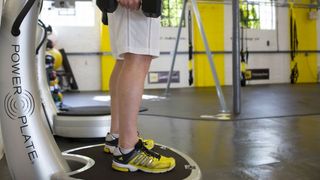How To Use The Power Plate To Improve Your Training
Step up to the plate to enhance your warm-ups, workouts and recovery sessions

There’s probably a Power Plate in your gym and you’ve probably never used it. These machines stand in the corner of the weights room, just waiting for someone to jump on board and experience the benefits of adding vibration to your training.
Those benefits are considerable and whether you’re looking to warm up for your workout, increase the difficulty of the workout itself or help your body to recover afterwards, the Power Plate can help. We asked Steve Powell, director of training and education at Power Plate, and Claire Finlay, founder of Transition Zone and Power Plate expert, to explain how it works.
What is a Power Plate and what are the benefits of using one?
“It’s a form of vibration training,” says Finlay. “The vibration travels through the muscles. It’s relaxing and contracting the muscles, so working on the Power Plate you get muscle fatigue much more quickly. If you’re doing a plank you might be able to hold that for 30, 40 seconds, but if you do it on a Power Plate you’ll find you tire much more quickly.
“It [vibration training] was devised by Russian cosmonauts. In space, you have to do about six to eight hours of weight-bearing exercise to maintain muscle mass in zero gravity. They found that using a vibrating platform halved their exercise time.”
“The evidence-based benefits of whole body vibration (WBV) are a reduction in pain, an increase in strength, power and flexibility, and enhanced metabolic demand,” says Powell. “Additionally, it can reduce swelling and muscle soreness, promoting quicker recovery between training sessions and from injury.”
See related
- The Beginner’s Guide To TRX Training
- The Best Workout Apps
- The Quick-Fire Core Workout You Can Do Anywhere
What kind of training can you use the Power Plate for?
It’s easy to use the Power Plate – just stand or put some part of your body on it and turn it on. You’ll find exercises you normally do on the floor like squats or the plank are suddenly much more challenging. However, this is far from the only way to use the Power Plate.
“You can use it in a warm-up before you run or lift weights,” says Powell, “or integrate it in a strength training workout or functional training session, combining it with medicine balls, battle ropes or even suspension training.
Get the Coach Newsletter
Sign up for workout ideas, training advice, reviews of the latest gear and more.
“Vibration can also be used to promote recovery and regeneration in a few short minutes after a workout. Not only does the massage elicit the physiological benefits of blood flow, improved lymphatic drainage and reduction in muscle soreness, it feels amazing and is a great way to relax the nervous system.”
How do I know what to do?
Many Power Plates have a touchscreen which will guide you through various sessions. To plan and familiarise yourself with a workout before a gym session, check out the free app on the App Store and Google Play. It contains a variety of resources that can help you use the machine effectively, including introductory videos, classes and general training tips.
“If you want to do a ten-, 20- or 30-minute full workout, try classes on demand,” says Powell. “If you want to follow a five-minute running-specific warm-up, go to coaching tips and we take you through each component step by step, with short clips of each exercise and recommended settings.”
What power setting should you use?
If you use the Power Plate app, you’ll get info on the best setting for your training. If not, it’s important not to overdo it with the shaking.
“For training you can set the rate at which the plates are vibrating from 30 to 40, and then there’s a high and a low,” says Finlay. “It’s normally 35 low. The reason why Power Plate is a shorter session normally is because that constant switching on and off of your muscles is so exhausting. If you put it on 50 high, it’s just a waste of time – it’s too much. It’s only used for massage on that higher setting.”

Nick Harris-Fry is a journalist who has been covering health and fitness since 2015. Nick is an avid runner, covering 70-110km a week, which gives him ample opportunity to test a wide range of running shoes and running gear. He is also the chief tester for fitness trackers and running watches, treadmills and exercise bikes, and workout headphones.
